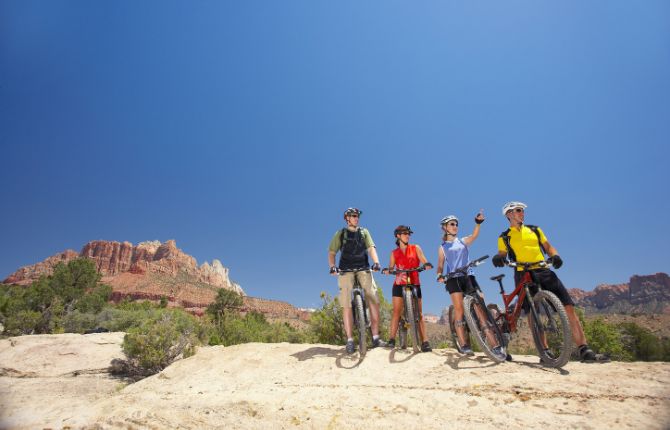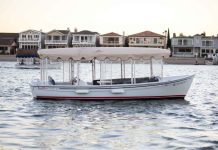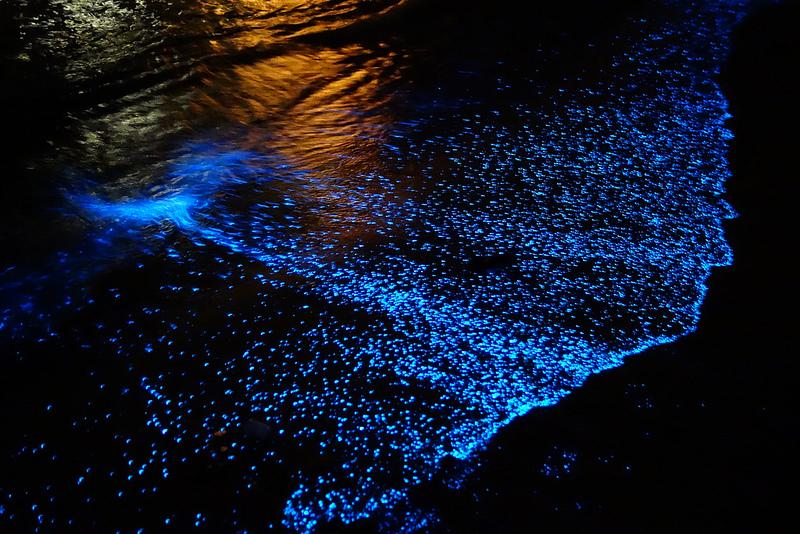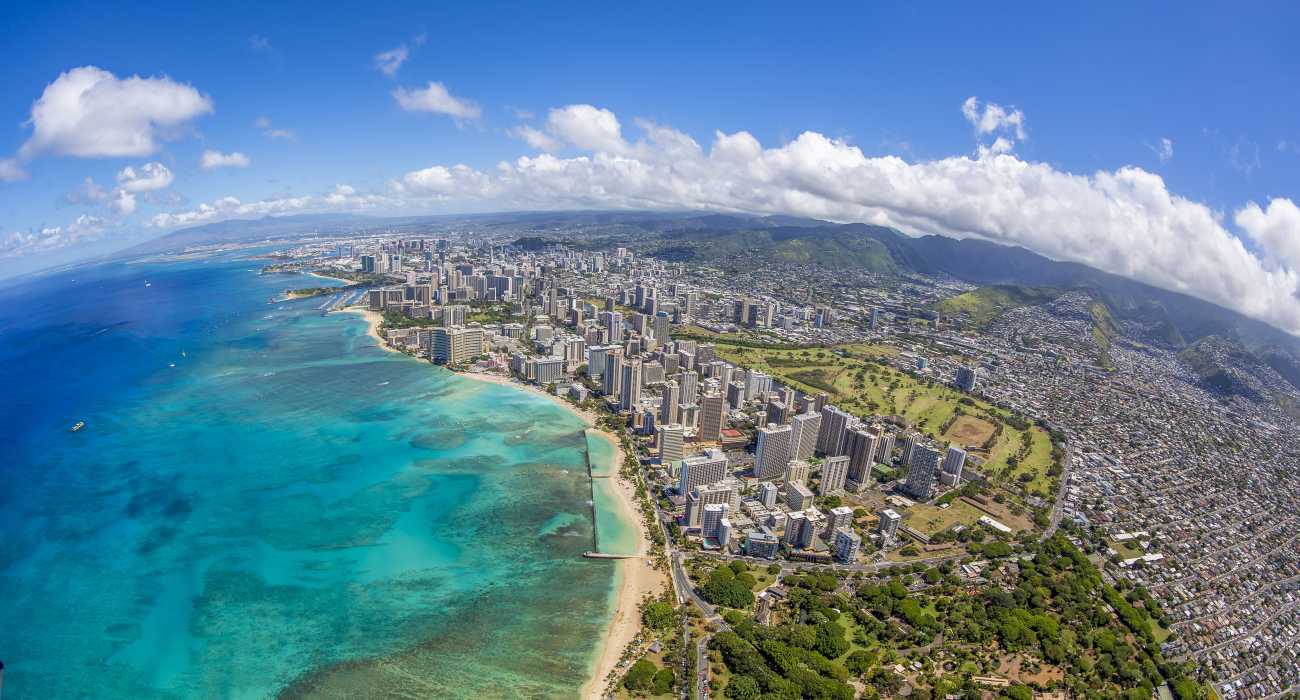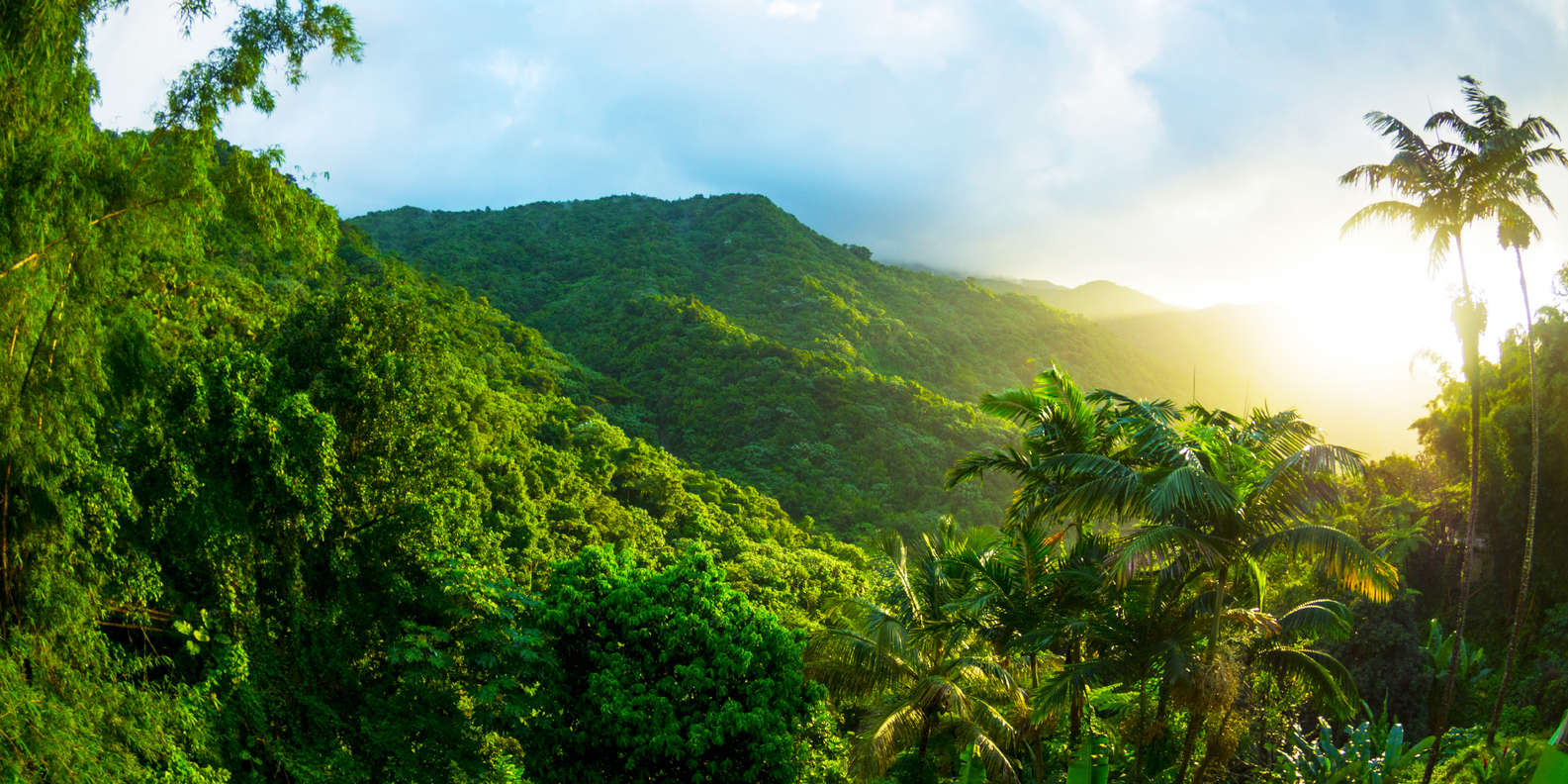Looking for the best things to do in Zion National Park?? Here’s the list with all the travel information you need to plan a family tour.
Zion-Mount Carmel Highway, Zion Canyon Scenic Drive, Observation Point, and Angel’s Landing are the top attractions in Zion National Park. And this park is a paradise for hikers and campers.
On the other hand, the park offers plenty of adventurous outdoor activities like rock climbing, canyoneering, and horseback riding.
Let’s discover the complete list of the things to do in Zion National Park. Just check and add them to your bucket list.
1. Things to Do in Zion National Park: Zion Canyon Scenic Drive
If you’ve never been to the area, you’ve got to try the Zion Canyon Scenic Drive. It’s a 57-mile drive that begins at the intersection of Highway 15 and Highway 9 and winds eastward to Mount Carmel Junction.
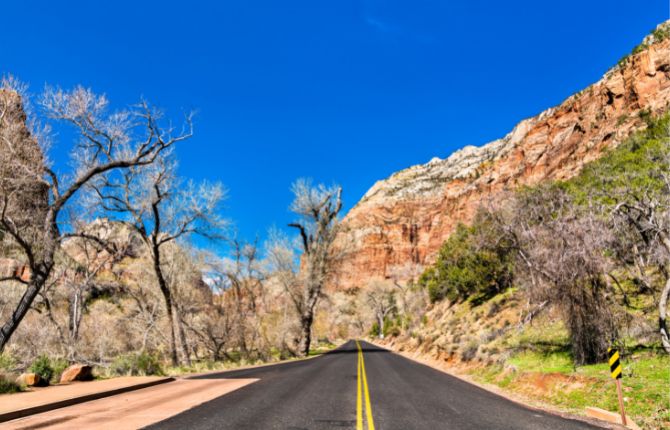
This scenic drive offers many vistas and is a great way to see all of the canyon’s beauty. You can also visit the Zion-Mount Carmel Junction near the eastern entrance.
Also, you can take the Zion Canyon Scenic Drive by bicycle. This road is a popular route for cyclists, and it allows you to avoid the long lines for the shuttle and the shared road with buses. (the shuttle bus is not operating during winter)
It also allows you to avoid the tourist crowds and will enable you to reach the park before most other people do. It means you can take in the sights before the park opens up to the general public.
Along this scenic road, you can view the canyon floor and towering cliff walls on both sides. And, of course, you can view the top attractions in the park, including Angels Landing and the Narrows.
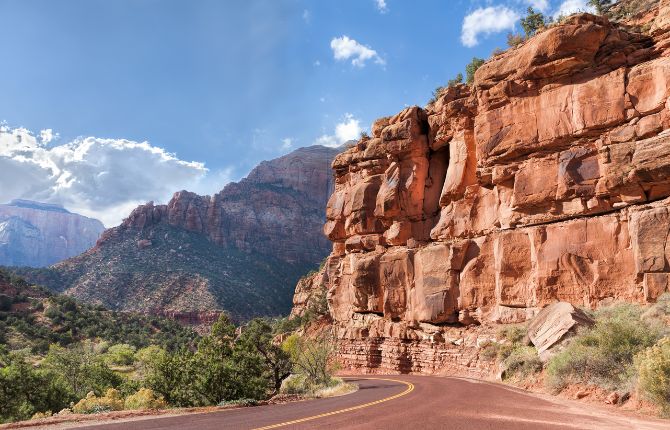
Visiting Zion Canyon is best during warm weather. The temperatures usually reach the mid-fifties in December and mid-fifteens in January and February. Light snow can fall in lower canyon areas, but the weather is generally mild.
If you’re planning a visit to the canyon during these months, try to visit in early spring, mid-fall, or winter to avoid the crowds. But, for optimal views, visit in the warmer months.
The main attraction of Zion is Checkerboard Mesa, but there are many other great attractions nearby. You can reach it on your own, without catching the free shuttle, and from any vehicle.
This sandstone butte is covered in crosshatches, which are the result of windblown sand, and vertical cracks caused by stress. It makes for an excellent photo opportunity. Check the weather forecast before setting out on the drive, though!
2. Things to Do in Zion National Park: Zion-Mount Carmel Highway
The Zion-Mount Carmel Hwy connects the canyon to the outside world. It is a 14-mile drive through breathtaking scenery.
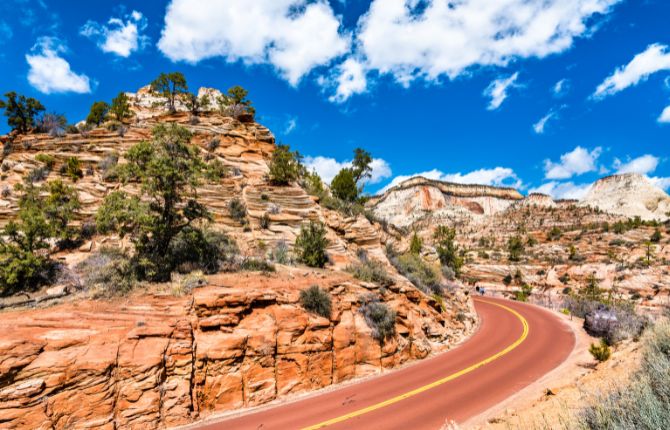
If you’re planning a road trip, consider taking the Zion-Mount Carmel highway. It’s a scenic drive through a Slickrock landscape.
Along the way, you’ll pass through a tunnel; a one-lane engineering feat blasted through the sandstone in the 1920s. Observation pullouts line the road, providing a glimpse of the canyon’s dramatic landscape.
The drive includes a steady climb and a narrow 1.1-mile tunnel that is not wide enough for RVs. If you are driving an RV, surely pay an extra fee and buy a pass before entering the tunnel.
And the park shuttle is not operating along the Zion-Mount Carmel Hwy.
After passing the tunnel, you will see the trailhead to Canyon Overlook Trail. It is a 0.5-mile scenic hike that leads you to a breathtaking viewpoint. So, do not miss it.
There are numerous hiking trails in the park, but if you’re not into strenuous hikes, the scenic bus route is a great way to see the park. While the main Zion Canyon is popular with tourists, you can also visit the lesser-visited Kolob Canyons.
You can drive up to five miles up the canyon to see some spectacular scenery. Take a break at a rest area en route and enjoy a picnic or lunch.
From the South entrance of the park, you can take a scenic drive through the park. The scenic drive follows the rim of a valley and provides breathtaking vistas of the park.
You can also stop at the Zion Canyon Museum to look at American Indian culture. This park is filled with natural wonders and is well worth the visit. If you’re looking for an outdoor adventure, you can also try horseback riding or rock climbing.
The Human History Museum is also worth a visit. It explains the history of the people who once lived here.
A short drive from Zion, Bryce Canyon National Park features a collection of hoodoos, spires of eroded limestone. It’s definitely worth the trip – and you’ll be glad you did!
3. Hikes in Zion National Park
Observation Point
If you have never been to Observation Point, you must do so now! This scenic overlook is well worth the trip. Known as the highest point in the park, it is a must-see when visiting Zion (6,507-foot elevation).
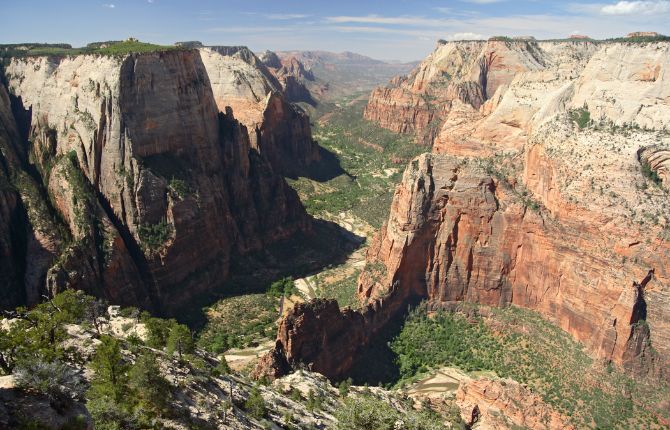
Its sweeping vistas and towering cliffs make it popular for photography and sightseeing. You can also enjoy the sights and sounds of nature while soaking in the views from the Observation Point.
Observation Point offers the best view of Zion. It is an excellent hiking destination with an eight-mile round-trip, and you can easily access it from Deer Trap Mountain or Cable Mountain.
You can also take the shuttle up near the trailhead of the Observation Point for a spectacular view of the park.
Observation Point hiking trail is a strenuous hike that runs over picturesque Navajo sandstone in Zion and through Echo Canyon. And finally, you are treated with dramatic views of the canyon.
As the Observation Point hiking trail is not crowded as Angel’s Landing, you can enjoy the views peacefully. So, start the trail at the Weeping Rock parking area and enjoy the scenery.
There are a lot of trails here. These trails lead to various natural features, including Weeping Rock and the Lower Emerald Pools.
There is also a wheelchair-accessible path known as Riverside Walk, which will take you through the narrows.
Unlike other hiking trails in the park, this hike involves a moderately strenuous climb. Despite the moderate difficulty level, the trail is well maintained, although not as well maintained as the others.
The trail climbs steadily and passes through a slot canyon for a short time. At the top of the trail, you will be rewarded with canyon views. You can also see the original trail through the canyon, including the rock formations that covered part of the path.
Angel’s Landing
Hiking to Angel’s Landing or Temple of Aeolus in Zion National Park is an unforgettable experience. The hike is not for the faint of heart; it can be challenging and crowded.
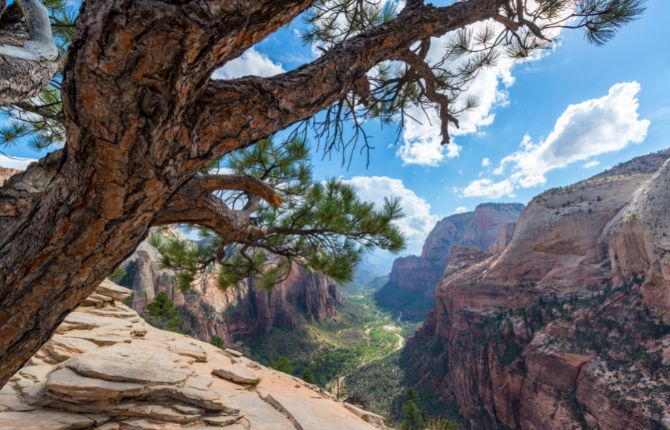
Start your hike early to avoid the midday heat and midday thunderstorms. Once you’ve finished the trail, you’ll be grateful you made an effort. To avoid crowds, you can opt to take the more comfortable Watchman Trail instead.
Angels Landing is a 1,488-foot tall rock formation that offers breathtaking views of Zion Canyon. Therefore, it is one of the most famous hikes in the park.
But, it is not for everyone because it is a strenuous 5.4-mile round-trip trail with narrow ridges and a huge elevation gain. The trail starts at the Grotto and will take around three and six hours to complete.
So, trying with kids and people with a fear of heights is not suitable.
Although Angel’s Landing trail is open year-round, summer is the most popular season, and it attracts thousands of hikers. Since the climate is extremely hot, get ready for that.
Another way to experience the beauty of Zion is to take a guided tour. The park’s visitor center offers information on hiking tours, including one through the canyon.
These guided tours are generally smaller than Angels Landing so that you can enjoy the scenery in a comfortable, safe environment. You can even choose between two different hiking trails: the Watchman and the Canyon Overlook. During a guided tour, you will get an overview of the Canyon and its surrounding areas.
While you’re at Zion National Park, you’ll have the opportunity to observe the night sky. The Human History Museum is an excellent place to see the stars.
If you prefer a more comfortable hike, you can choose the paved Pa’rus Trail instead. However, be sure to stay safe as there are cliffs in Zion National Park and mountain lions in the area.
In addition to hiking trails, there are many other activities that you can do while exploring Zion National Park. The Abraham, Isaac, and Jacob Mountains are prominent landmarks and are easily accessible from the park’s Sand Bench Trail.
Visitors can also stay at the Sand Bench Lodge, which is the only lodging within the park’s boundaries. The Sand Bench Lodge has been a landmark of Zion since the 1920s and was remodeled in 1990 to restore the rustic appeal of the historic building.
Emerald Pools Trail
If you have never hiked the Emerald Pools Trail in Zion National Park, you must do so before you die! The scenic trail features three swimming pools, which you can access from the lower Emerald Pool trail.
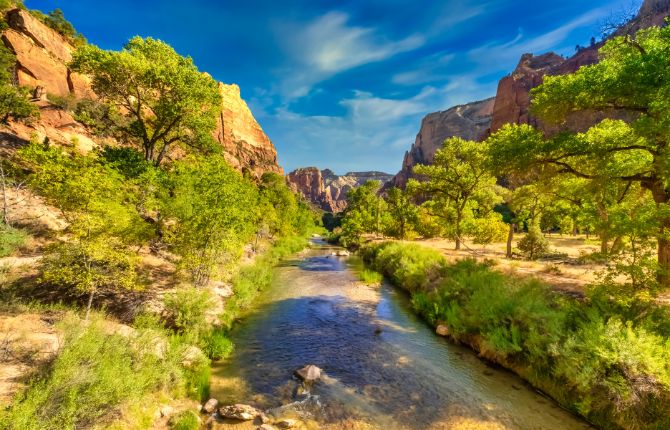
This trail is easy enough for children and hikers of all fitness levels. It takes approximately three hours to complete the entire trail, with a steep climb at the start. The trail is 2.2 miles long.
It has about 300 feet of elevation gain to Middle Emerald Pools and another 200-ft gain to Upper Emerald Pools.
If you’re looking for a short hike for younger children, the Emerald Pools Trail is a perfect choice. This short trail leads to a viewpoint where you can enjoy a stunning view of the area.
For a more challenging hike, you can continue on to the Middle Trail. This paved trail starts across the street from Zion Lodge and climbs the ridge to a series of viewpoints above the lower pool.
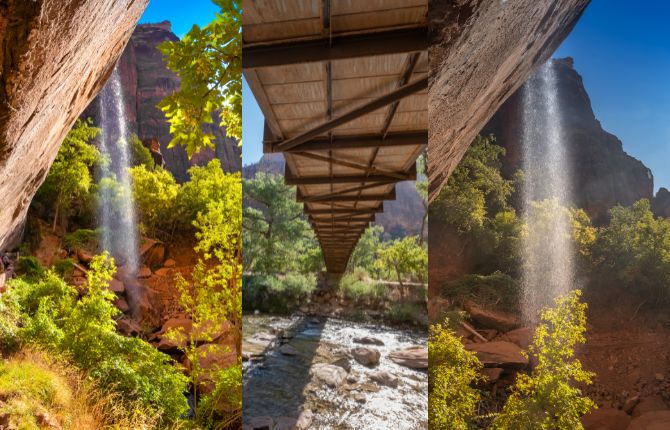
After ascending Middle Trail, you can reach the Upper Emerald Pool. This trail features a waterfall that falls several feet and is very dramatic during runoff.
The Middle Trail is easy to follow, but you should bring a change of clothes for the trail as it is steep and eroded in some places.
You can hike the lower Emerald Pools trail if you’re looking for a shorter hike. If you’d prefer to hike the higher Emerald Pools trail, you can walk for about 90 minutes.
A shuttle stop near the Temple of Sinawava also takes you to the Riverside Walk, an accessible pathway through Zion Canyon.
The Emerald Pools Trail in Zion National Park is a great way to enjoy the park’s spectacular scenery.
You can also visit the Human History Museum, which highlights the area’s cultural history. This is a must-do if you’re a first-time visitor to Zion. It’s free and well-marked.
Canyon Overlook Trail
If you’re visiting Zion National Park, you’ll definitely want to check out the Canyon Overlook Trail (a one-mile trail). It features incredible views of the surrounding canyon and a zigzag path carved into the rock.
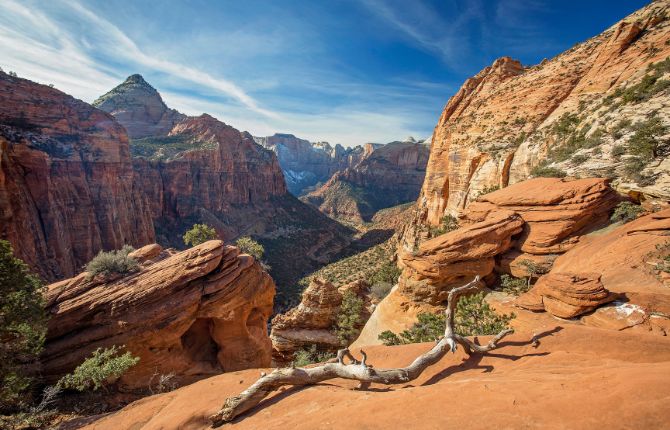
You’ll also notice hundreds of feet of waterfalls on both sides of the ridge. Vertigo sufferers should be sure to grab the handrails along the way. But, this trial is not recommended for young children.
The trailhead to Canyon Overlook is located at the immediate exit of the tunnel (east side of the tunnel).
While the canyon is open year-round, hiking is best done during the coolest months of the year, like March through October. This means the weather will be mild, and the temperatures won’t be too high.
The park is also closed during heavy snowmelt in the spring and autumn, which makes hiking in Zion National Park more difficult.
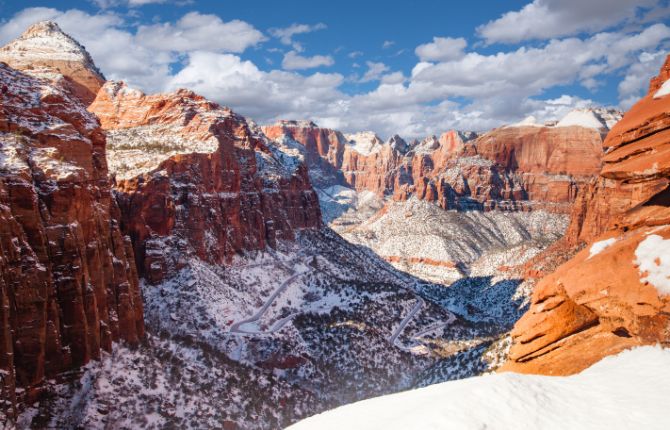
If you’re looking for a more adventurous hike, try the Canyon Overlook Trail, popular with experienced and novice hikers.
You can also take the Canyon Overlook Trail to see the park’s most infamous cliffs. Located at the end of the Zion-Mount Carmel Highway, this scenic drive will give you a unique view of the park.
The scenic drive and the campgrounds are located along Route 9, so you won’t have a problem reaching them. Just make sure you leave an as little trace as possible! In the end, you’ll thank yourself for your decision.
A horseback tour is another great option for tourists who are looking to enjoy the beautiful natural surroundings. These tours wind up past pine trees to a high peak that offers breathtaking views of Zion National Park.
You’ll see dozens of peaks and valleys and can even get a view of the Grand Canyon from a high point. In any case, it’s a hike you won’t forget.
East Rim Trail
For a truly off-the-beaten-path experience, consider hiking the East Rim Trail in Zion National Park.
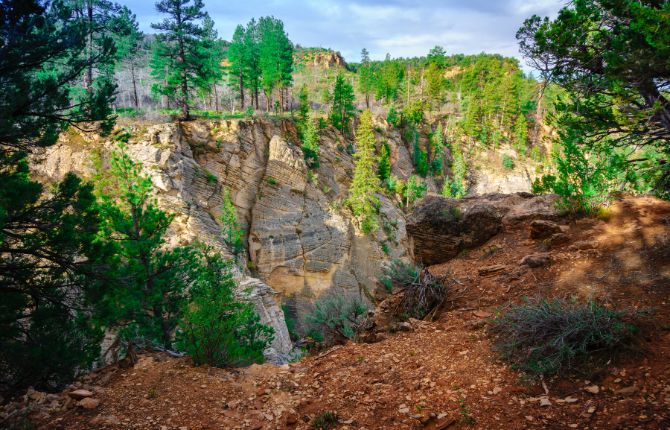
This unique route will take you over 2,000 feet in elevation and over the edge of a 2,200-foot cliff. Upon reaching the top, you’ll have an unparalleled view of the park and the surrounding canyons.
You’ll also have the opportunity to take in the views of the park’s wildlife and countless viewpoints along the trail.
You may want to consider a camping trip at Lava Point, Zion’s highest point. The campgrounds are primitive, so you’ll want to plan accordingly.
You’ll have to keep a sharp eye on your surroundings and know how to get back to the main road. You can also check out photographer Joe Braun’s website to get a better feel for the Upper East Canyon.
Make sure to spend some time hiking in the Checkerboard Mesa Canyon for some great views of the Virgin River.
The East Rim Trail in Zion National Park features spectacular canyon views. Many spots along the trail provide access to the Virgin River.
You may be able to walk through the springs at Weeping Rock and enjoy the water-loving plants that adorn it. Although the trail itself is short, you may wish to explore the other trails in the area.
Echo Canyon, Observation Point, and Hidden Canyon are just a few of the hikes available.
West Rim Trail
The West Rim Trail in Zion National Park is a popular hiking trail traverses a portion of the canyon rim.
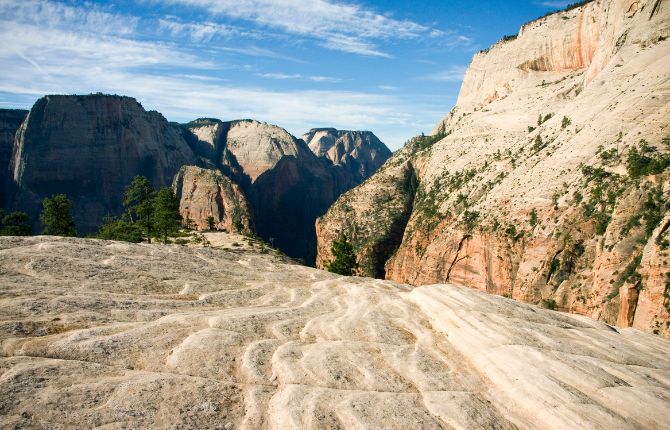
The West Rim Trail follows switchbacks along a ridgetop and then descends into Zion Canyon via the west rim. The trail begins at the Lava Point trailhead and eventually emerges at the Grotto trailhead at mile 3.2 on Zion Canyon Road.
Visitors can hike the West Rim Trail on their own or rent a guide for the hike. The trailhead is near the park, making it convenient for visitors who don’t want to rent equipment.
Hikers can enjoy scenic views from the west rim of the canyon. The trail begins with a pleasant stroll on the upper plateau.
The trail ends at campsite 9, where you can take a break in the huts. The trail also offers a beautiful view of the left fork of North Creek and the South Guardian Angel peak.
It takes approximately 2 hours to complete the trail. You’ll need to leave one vehicle at each location to reach the trailhead.
The Angel’s Landing hike is also a popular attraction and a part of the West Rim Trail. Once you’ve climbed to the top of the cliff, you can enjoy the view from the Angels Landing viewpoint.
The Virgin Riverwalk is about 0.2 miles long and is suitable for all ages. The perfect time to hike is at sunset when the colors of the canyon are brilliant gold.
It provides unobstructed views of Abraham, Isaac, and Jacob mountains, named after biblical figures. During the summer months, this walk is popular, so you might want to visit in the off-season to avoid crowds.
The Narrows
If you’ve never visited this part of Utah, you may be surprised at what you’re missing. If you’ve never visited Zion National Park, this article will give you some helpful tips to make the most of your trip.
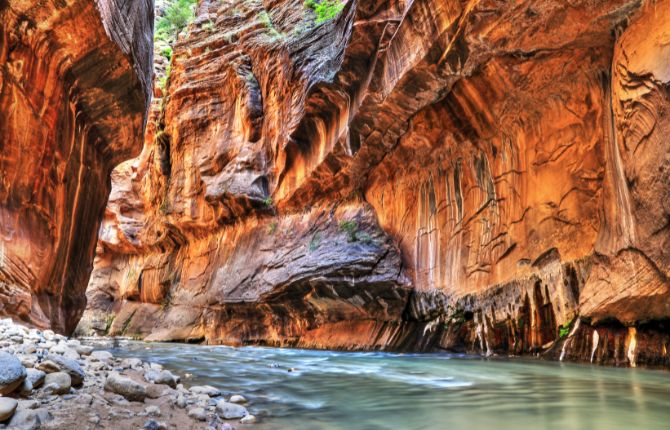
The Narrows in Zion National Park is an iconic hike. You’ll have to wade through a narrow, rocky canyon while admiring the breathtaking landscapes. The hike is about 10 miles long and involves a lit of climbing, but shorter distances can be equally spectacular.
Don’t worry; you can turn around at any point. But, hikers cannot go beyond Big Springs. So, most hikers try a round-trip hike of six to eight miles.
Its signature feature is the slot canyon. So, surely wear suitable wet shoes and hike through the spectacular rock-cut located on the Virgin River.
Make sure to obtain a permit for the hike if they plan to climb The Narrows. And also, keep in mind, that the water is cold and the rocks are slippery.
The Narrows is one of the most popular hikes in Zion National Park. It’s a great way to enjoy the natural rock formations. There are numerous observation pullouts scattered along the way.
If you plan on doing this hike, you should go during the summer months, when the park is more open and the river recedes from the spring runoff making a safe water flow for hikers. But make sure you check with the Zion National Park website for updated information.
You’ll find everything you need to know about this beautiful area. And don’t forget to rent the proper gear! After all, you don’t want to end up without a good pair of hiking boots!
If you’re looking for a lighter option than hiking The Narrows, consider taking a paved walkway instead. This walk begins at the Gateway to The Narrows and is often populated with people heading to the canyon.
You can view the grand canyon walls in the distance, as well as the trees that surround it. For the most spectacular views, plan to hike the Narrows before it gets too hot.
Watchman Overlook Trail
While most people choose the more famous hikes in Zion National Park, the Watchman Overlook Trail is a fantastic alternative.
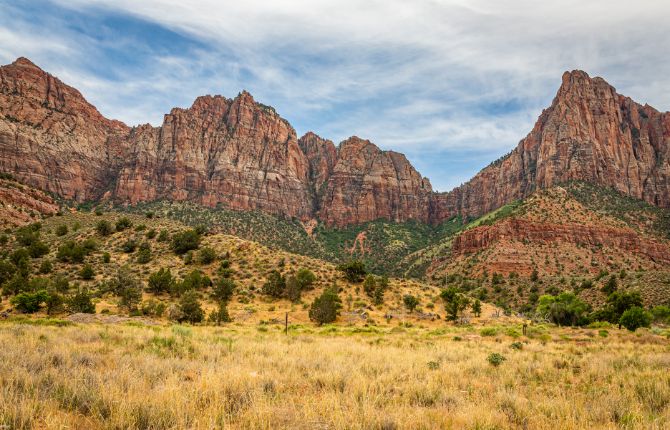
It is a three-mile roundtrip hike that provides incredible views. You can easily reach the trailhead from the Visitor’s Center parking lot. It is also within walking distance. And all the facilities like restrooms and water filling stations are available here.
Watchman trail is 3.3 miles roundtrip hike that takes around two hours to complete. It is a great option for those who are looking for a more moderate hike without requiring a shuttle. (Bikes are not permitted along the trail)
Starting from a relatively flat area by the river, the trail reaches above 368 ft. Finally, you are treated to magnificent views of the Town of Springdale, temples and Towers, lower Zion Canyon, and Watchman.
If you are planning a hike to the Watchman Overlook Trail, make sure to bring along plenty of layers. The weather in Zion can change quickly, so it is important to dress in layers.
The Watchman Trail is a short and easy hike that provides great views of the Springdale area. If you’d rather walk to the overlook, it is located near the Temple of Sinawava.
Remember to bring your camera and plenty of sunscreens. Zion National Park is a unique destination and a once-in-a-lifetime experience. To make the most of your visit, make sure you plan a week’s worth of activities.
Another popular hiking trail is the Riverside Walk. This two-mile round trip hike takes only one hour and is the perfect half-day hike. It is also an excellent option for those who are new to hiking.
The Narrows trail is a wonderful option for hiking in Zion. The Narrows trail leads to Big Spring and is one of the most scenic trails in Zion National Park. However, be aware that the trail’s accessibility depends on water levels, so it is best to hike this trail during late spring or summer.
You can also hike to the Hanging Gardens of Zion from this trail. Just be sure to check the water level before you go – this trail is not recommended for those with a fear of heights.
Pa’rus Trail
You may have heard about Pa’rus Trail in Zion National Park but have you ever been curious about how it is?
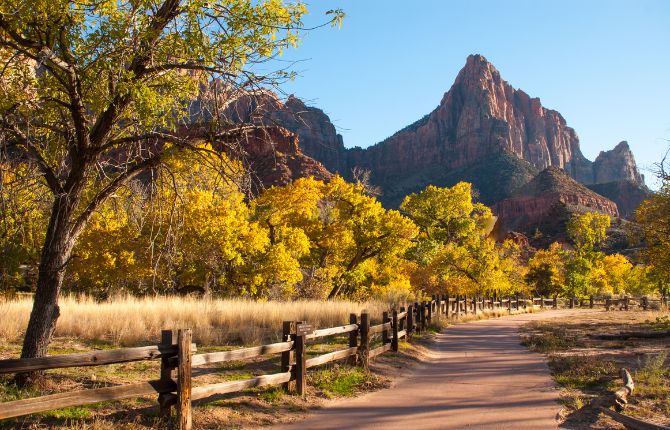
There are several reasons to hike this trail, including the beautiful scenery and the paved trail. However, before you go hiking in the park, you should know some facts about the park.
The Pa’rus Trail is an easy-to-navigate 3.5-miles paved trail path that winds alongside the Virgin River and offers panoramic views of the canyon. This hike can be enjoyed in all weather conditions, and it’s wheelchair and bicycle-friendly.
You can also bike on this trail, and it’s pet friendly too. There are restrooms and water filling stations along the trail. After your hike, you can head back to the Visitor Center for a refreshing drink or snack.
The Pa’rus Trail begins from the north parking lot outside of the tollbooth entrance. It skirts up alongside the South Campground before intersecting with the Floor of the Valley Road and the highway.
It also passes the museum and park headquarters. It ends at a junction with the Floor of Valley Road and Highway 9. From here, you can access the Temple of Sinawava. It is a great hike for families with children, but be warned that the sun can be fierce!
If you’re planning to hike or bike on this hike, make sure you bring a bike! Zion National Park’s shuttles don’t pass cyclists on the Zion Scenic Drive, so biking on it is more enjoyable than a vehicle.
If you’re not riding a bike, you can always rent one and get back on the trail. The Zion Human History Museum is located near the trail. You can learn about the Indigenous settlers of Zion as well as its Euro-American colonizers.
Address: Hurricane, UT 84737, United States
4. Weeping Rock
A trip to Weeping Rock in Zion National Park is one of the most memorable adventures of your life.
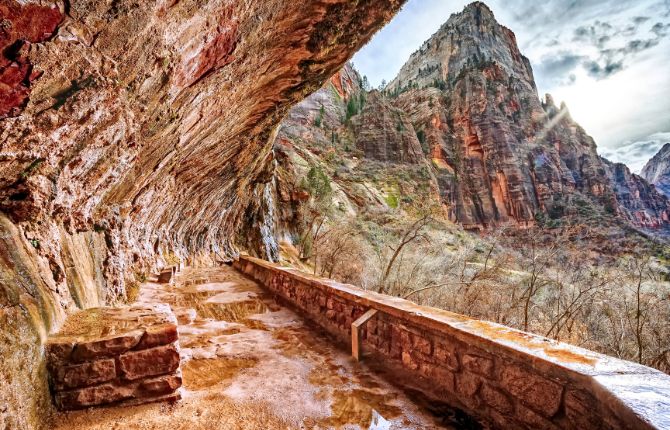
While it’s an easy hike, you can get wet and experience a real sense of awe by taking a dip in the roaring river that plunges over 2,000 feet.
It is only a half-mile round-trip that can try by anyone (but, it is not wheelchair accessible). Once you reach Weeping Rock, you can see a large alcove carved into a cliff wall surprisingly with a constant supply of water flowing over the face.
This place turns into a waterfall, especially during spring and rainy days. So, surely expect to get wet on this hike.
Also, you can see beautiful hanging gardens and mountains along the cliff wall.
The park’s visitor center and website can also give you information on the current water levels in Zion Canyon.
You must note that flash floods are a real danger because heavy snowmelt in the spring strengthens the river’s current. In the event of a flash flood, the hike is closed.
After hiking through the park, be sure to visit the Human History Museum. This small but informative museum tells the story of human habitation in Zion National Park throughout the years.
Exhibits in the museum include Native American cultures, pioneer settlements, and water. A huge model of the park is also available for viewing. A visit to the museum might inspire you to do a day hike after seeing the majesty of the park.
If you love stargazing, Zion National Park has many guided tours. One of the more popular tours is a tour through the Kolob Canyons. This five-mile road offers spectacular views. Several popular hikes in the park include Kolob Canyons Viewpoint and Pa’rus Trail.
There are many other hiking trails available in Zion National Park. It’s also worth taking a guided tour through the Slot Canyons of East Zion.
5. Riverside Walk
The Riverside Walk is a popular hiking trail in Zion National Park. The walk itself is easy and scenic, but it can also be dangerous for inexperienced hikers.
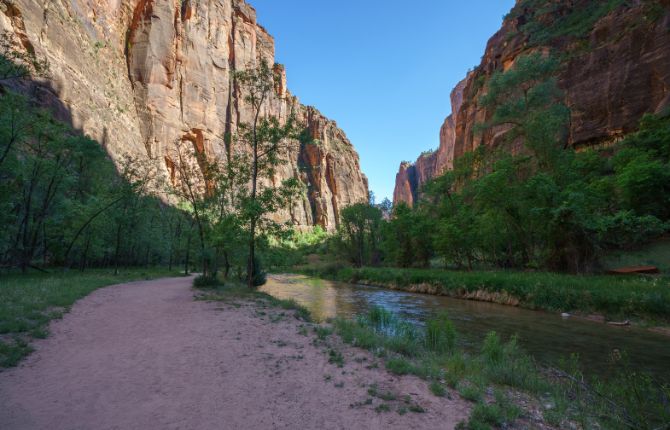
This scenic 2.2-mile round-trip paved trail runs along the Virgin River. You can start it at the last stop on the Zion shuttle bus.
Hikers can see beautiful rock walls, hanging gardens, diverse birds, and wildlife. So, the Riverside Walk hiking trail is like a paradise for nature lovers.
To avoid the risks, it is only recommended for fit hikers. The path is about six-five hundred feet high and has a unique crosshatched pattern.
Hikers love Riverside Walk because it offers views of the canyon’s sandstone walls and a unique geology exhibit.
You’ll see more than just spectacular scenery along the way, too. You can see hundreds of bird species, including California condors and peregrine falcons. You’ll also see hummingbirds, woodpeckers, chickadees, and owls.
The best time to go bird-watching is early April, mid-fall, and winter when the trees are lush and full of life.
One of the best ways to see the park’s scenic spots is from an ATV or Jeep. A tour guide will help you navigate the park, and can tell you more about its history and culture. There’s also a museum with information about the park’s wildlife, geology, and culture.
You can even learn about canyoneering if you want. It’s one of the best ways to experience Zion!
Address: Riverside Walk, Springdale, UT 84767, United States Phone: +1 435-772-3256
6. Lower Emerald Pools
If you want to hike through Zion National Park and experience beautiful waterfalls, you should try the Lower Emerald Pools trail.
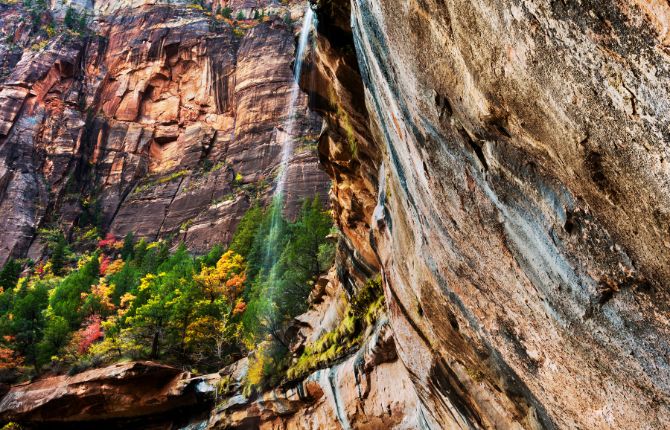
Lower Emerald Pools trail is more similar to Weeping Rock in many ways because it also features a rock wall, flowing water, and a pool. And the trail is only a .6-mile round-trip paved trail. You can find the trailhead at the Zion Lodge shuttle bus stop #5.
Spring is the best time to try this trail as the water is flowing over the wall.
The trail is relatively easy to follow and begins across from Zion Lodge. The Lower Emerald Pools trail is one of the easiest hikes in the park, though the Upper Extension trail requires more effort.
If you walk further behind the wall, you can reach the Middle and Upper Emerald Pools as well. You can also take the trail to Kayenta, which is less popular and is a more scenic option.
To get to Lower Emerald Pools, you’ll first have to head to the Kolob Canyon portion of the park, which is less traveled than the main park. There is a small visitor center here, but it provides the same amenities as the main park.
Inside, there are bathrooms, maps, guides, and a geology exhibit. You will need to purchase a National Park pass to visit Kolob Canyons.
7. Checkerboard Mesa
You’ve heard about the famous Checkerboard Mesa in Zion, but have you ever seen this formation in person?
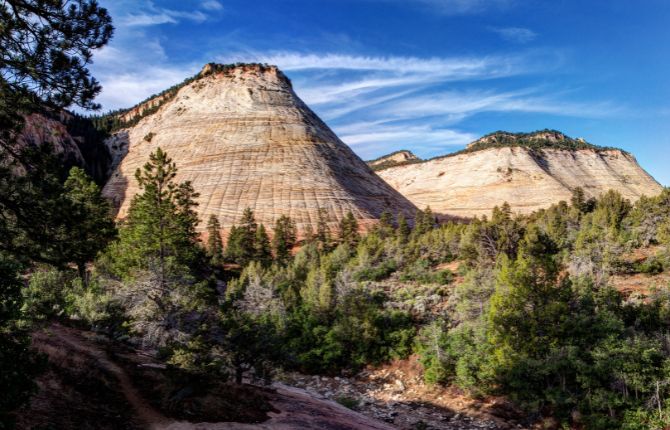
This sandstone butte has an unusual crack pattern, similar to the grid pattern of a checkerboard. From the top, you’ll see desert tanks and odd-shaped outcrops of twisted sandstone. If you’re a photographer, this spot should be on your itinerary!
When you enter Zion from its East Entrance, Checkerboard Mesa is the first stop. You can see unique amber-colored stones, mountains, and large pine trees.
Although there’s a parking area near Checkerboard Mesa in Zion, it can only accommodate for few cars.
If you’re planning a trip to Zion, you’ll want to take advantage of the natural beauty of the park and its beautiful scenery. The area has an abundance of wildlife, including California condors, peregrine falcons, and hummingbirds.
During the spring, trees are green and birds are plentiful. Make sure to bring water and a cool head covering. To make the most of your vacation, book your accommodations early!
If you’re planning a day trip to Zion National Park, don’t forget your hiking shoes! You’ll need sturdy hiking shoes with sticky rubber soles to tackle the rugged terrain.
Also, you’ll need to be prepared for bushwhacking and navigation skills. And be prepared for full sun for most of the hike. If you’re traveling by car, be sure to check out the Pullouts nearby to take a photo or two.
8. Human History Museum
If you’re visiting Zion National Park for the first time, a visit to the Human History Museum will definitely be worth the effort.
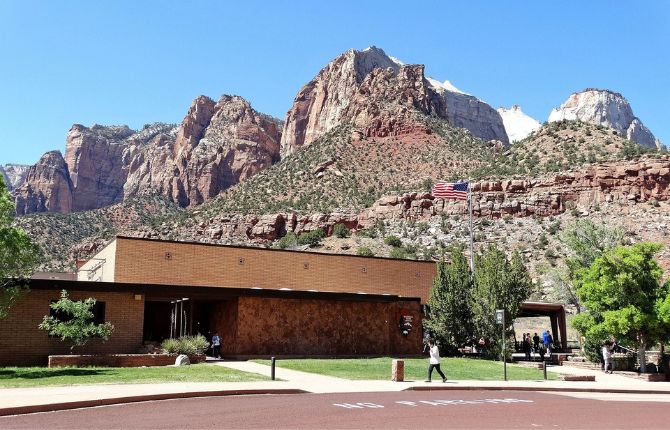
Located in the main visitor center, this small museum traces the history of human habitation in the park. There are exhibits about geography, history, and settlers, as well as rare artifacts and photographs of park employees. And also, there’s a huge model of the park and its surrounding.
Visitors will also find a variety of hands-on activities, including a children’s activity corner. This museum is the first stop of the park shuttle bus.
Human History Museum is located a half-mile walk from the southern entrance station. Inside, you’ll find a modest exhibit detailing the park’s history. The Human-History Museum also hosts occasional ranger talks.
The permanent collection of this museum includes more information about pioneer settlements, American Indian culture, and the formation of Zion. You can ask any question from the knowledgeable rangers at the museum.
The paved Pa’rus Trail parallels the road for two miles from South Campground to the main canyon junction. You can also check out the Zion Nature Center, which features many interactive exhibits.
The Checkerboard Mesa is an interesting geology feature in Zion. It is a cone-shaped formation formed by windblown sand and cracks in the rock by stress. The Mesa is one of the park’s most popular destinations.
After the museum, you can continue to explore the Narrows and check out Checkerboard Mesa. This formation is easily visible from the entrance to the park.
Address: Zion National Park Rd, Springdale, UT 84767, United States Phone: +1 435-772-3256
9. Canyon Trail Rides
For those who are planning a vacation to Zion National Park, horseback riding is a great activity.
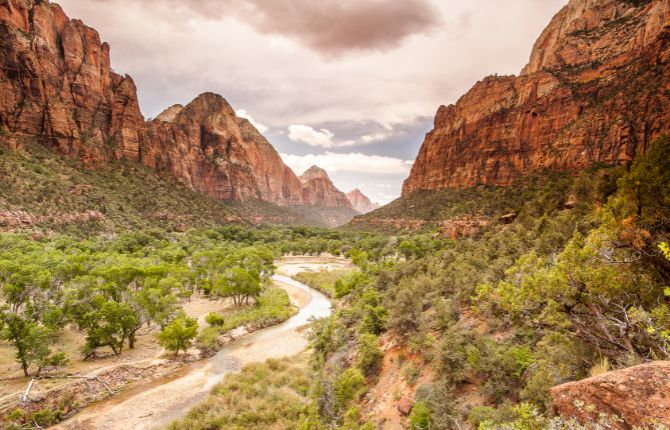
You can find outfitters and guides who offer guided rides through the park. There are several different riding trails in the park. The terrain varies from colorful desert landscapes to narrow canyons to alpine forests.
From March to October is the time to take a ride with your family and friends. Normally, the rides take around one hour and take you along the scenic Virgin River. If you are an experienced horseback rider, there are longer tours as well.
Begin your day by riding a horse through the park’s beautiful canyons. You can also view a variety of wildlife along this trail.
You can also try the Riverside Walk that stretches alongside the Virgin River.
The Narrows hike is one of the most popular in the park, but you can also hike the Riverside Walk if you’re not a fan of strenuous exercise.
If you’re traveling with a dog, you may want to consider the Emerald Pools hike. The 2.2-mile walk through the canyon includes 3 waterfalls.
10. Canyoneering
For those who have never tried canyoneering before, Zion National Park in Utah offers several canyoneering excursions.
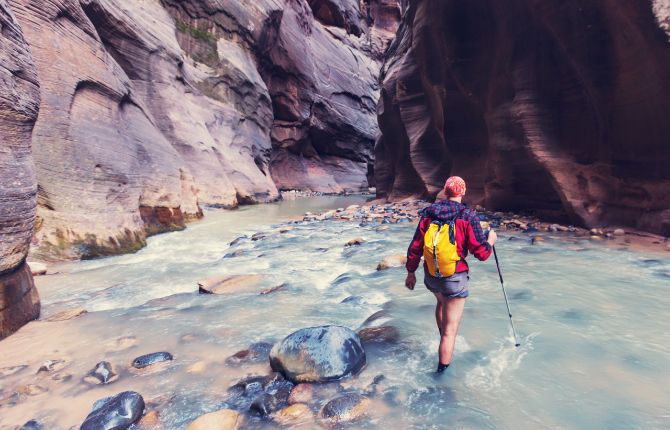
You can choose between a family hike or a challenging canyoneering excursion. Either way, it is worth the effort to visit this park to experience this thrilling activity.
Although there are no major hazards while canyoneering in Zion, it is crucial to know the right season for the activity. Avoid visiting the park during winter months when flash flooding is a common occurrence.
Spring, fall, and summer months are ideal seasons for canyoneering, and each season has its own unique experience. Depending on the season, you’ll have different experiences and be more comfortable with the activity.
Beginner-friendly canyoneering adventures can be found in Elkheart Canyon and Coral Sands. These two canyons are characterized by short approach/exit hikes, fun rappels, and deep slot canyon sections.
Another popular canyoneering adventure is the Left Fork (Subway), a nearly 8-mile route that features six scenic rappels. Whether you’re a novice or a seasoned veteran, you’re sure to find a canyoneering adventure at Zion National Park.
The Zion-Mount Carmel Tunnel connects the Visitor Center to the east entrance of the park. From there, you’ll be able to see the spectacular scenery of Zion Canyon.
While the Weeping Rock trailhead has been closed due to rockfall, you can still reach Observation Point by taking the East Mesa Trail. Alternatively, you can hike the 20-mile East Rim Trail.
11. Things to Do in Zion National Park: Rock Climbing
If you love adventure, you might want to try Rock Climbing in Zion National Park. There are many different types of rock formations in the park, and the different terrains require different gear.
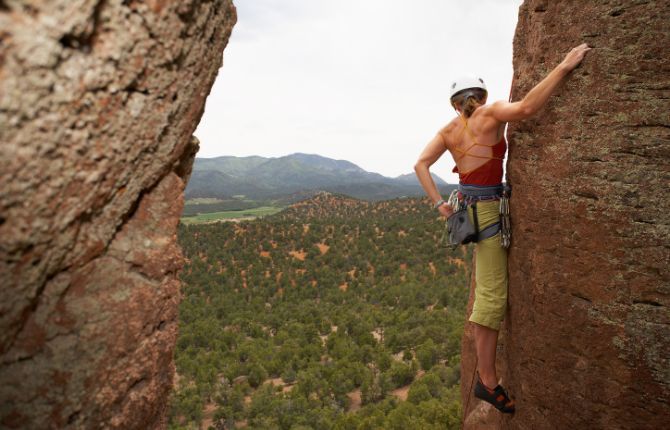
Experts can tell you which gear is right for the specific rock formation. There are several types of rock climbing opportunities in Zion, and we’ll break them down for you in this article.
One of the best parts of Zion National Park is its canyon walls. The canyon walls tower hundreds of feet. There are also a number of other beautiful sights, including the Floating Rock, Veiled Falls, Alcoves, and Mystery Falls.
If you want to climb the crags, you’ll need to plan ahead because the park is often very popular, and permits can fill up fast.
There are many things to do in Zion National Park. For the more adventurous, you can try rock climbing in the Narrows. This hike will test your stamina, as it will take you through narrow canyons.
You can also take in the views from the Floor of Valley Road. The checkerboard mesa is 6,670 feet tall and is an incredible sight. To see the entire park, you can also take a tour.
One of the most famous trails in Zion National Park is Angels Landing. This climb takes four to five hours and climbs 1,488 feet. It’s best for people without a fear of heights.
This hike is best done during sunset, which will give you the best view of the canyon. And since you’re up there, you’ll be rewarded with a stunning view of the canyon!
12. Things to Do in Zion National Park: Camping
There are plenty of free campsites throughout the park. Whether you’re traveling on a budget or need to get away from the crowds, these sites are close to both park entrances.
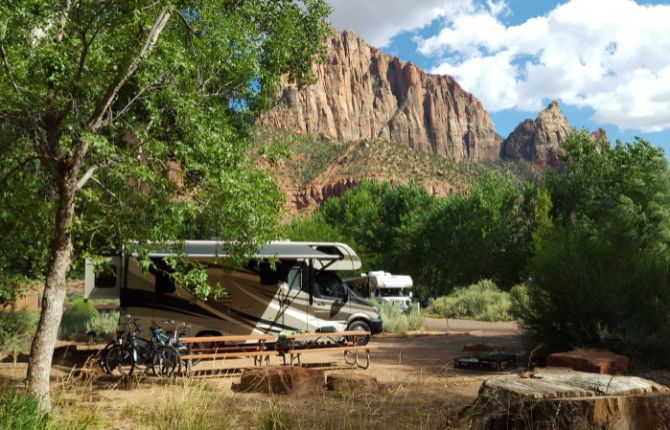
These campgrounds also have flush toilets, drinking water, and electrical hookups. You can also find wheelchair-accessible sites here.
South Campground and Watchman Campground are other famous campgrounds located near the town of Springdale.
You can camp on first-come-first-serve sites in the Lava Point Campground (located 50 minutes from the Zion Canyon section of the park). There is no fee for this site, but there are vault toilets and no showers or drinking water.
You can also find RV Parks and Resorts near Zion National Park’s south entrance. Whether you camp in an RV, tent, or trailer, make sure to arrive early in the day to find a good spot.
If you’re camping in Zion, be sure to check the weather before you go. Summer temperatures can easily exceed 100 degrees. Winter temperatures rarely snow in the area, but winter temperatures can reach thirty degrees.
The shoulder season is May, October, and November, when temperatures are pleasant, but the crowds are significantly less than during the high season. As a rule of thumb, June to September have the highest visitor numbers, and December to April see the least.
Another great activity in Zion is canyoneering, which involves propelling yourself down a cliff. Canyoneering can be done on a short trail or as part of a longer hike.
Weeping Rock is a favorite spot, but the park also offers longer hikes such as Observation Point and Hidden Canyon. The best time to enjoy the park is during sunset! And be sure to bring plenty of water and sunscreen!
13. Things to Do in Zion National Park: Kolob Canyons
If you want to see more than the famous Zion Canyon, check out the Kolob Canyons in Zion National Park.
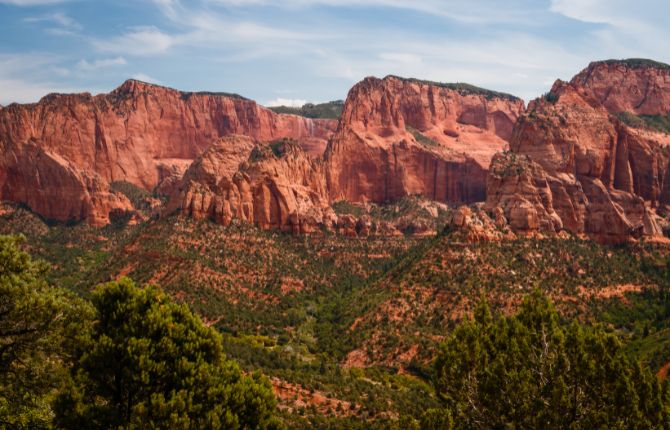
Located just one hour from the main park gates, these less-known canyons feature 2,000-foot cliff walls, hiking trails, wildlife, and viewpoints. There is no better place to experience the unique landscape of Zion National Park than in the Kolob Canyons.
The trails in Kolob Canyon are varied and offer diverse scenery. Some are easy and accessible, while others can be challenging. Depending on your skill level, there are even hiking trails that require canyoneering and rock climbing.
These trails are not as popular as the ones in other parts of Zion, so be prepared for a less crowded environment. Moreover, Kolob Canyon is full of lush plants and vegetation.
There are more than ten scenic hiking trails in Kolob Canyon. For example, the one-mile Timber Creek Overlook trail is one of the most highlighted ones.
This lesser-known scenic area offers several incredible viewpoints along the five-mile Kolob Canyons Road.
First, visit the Zion Canyon section. It is located near Kanarraville, about 40 miles away. From the Kolob Canyons, you must travel about 50 minutes by car. While it is possible to visit this section by car, it is not recommended for first-time visitors to Zion.
You can reach it from the west or east. Once you get the Kolob Canyons, make sure you take the time to explore all its natural beauty.
Once you arrive at the Kolob Canyons, you can take one of the many hiking trails that lead up to Taylor Creek. The first of these is the Taylor Creek Trail, which runs up the middle fork of the stream.
Starting at the parking lot two miles from the park entrance, you can follow the trail 2.2 miles upstream. You can stop here to view Double Arch Alcove, a Navajo sandstone formation between towering walls. Another popular hike is the North Taylor Creek trail.
Address: 3752 E Kolob Canyon Rd, New Harmony, UT 84757, United States Phone: +1 435-586-9548


